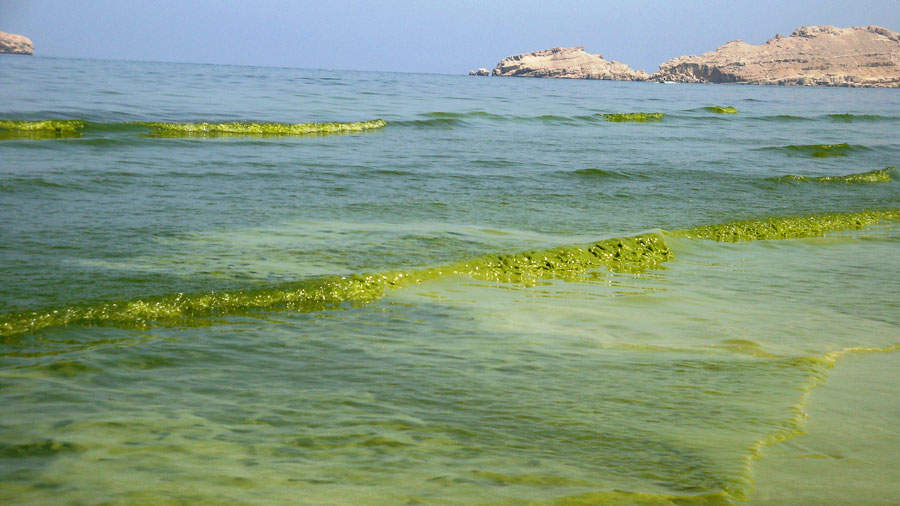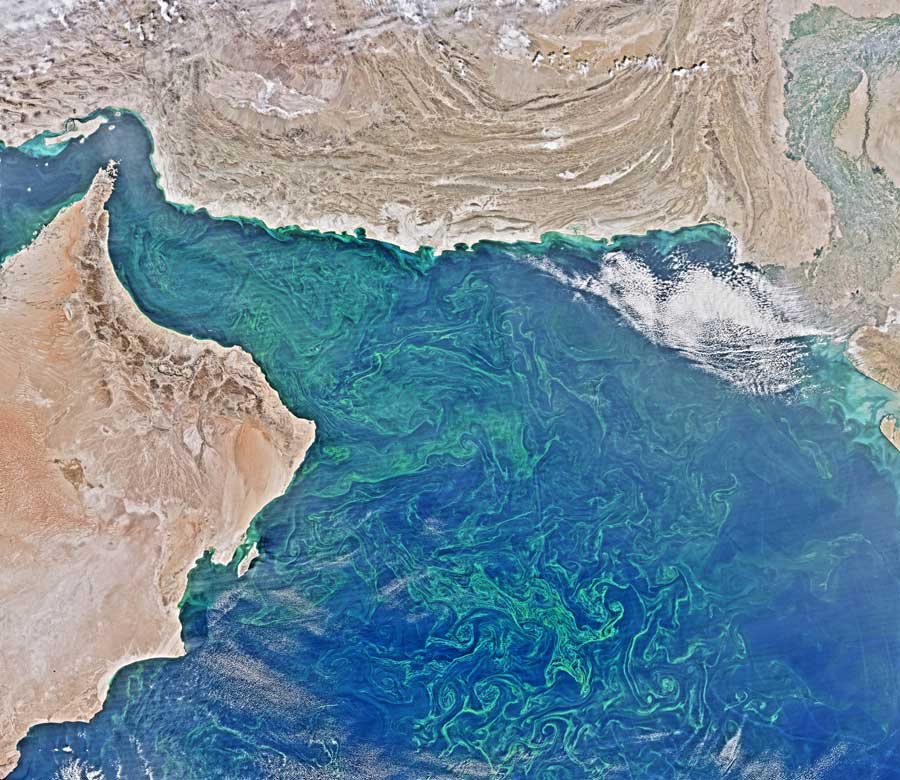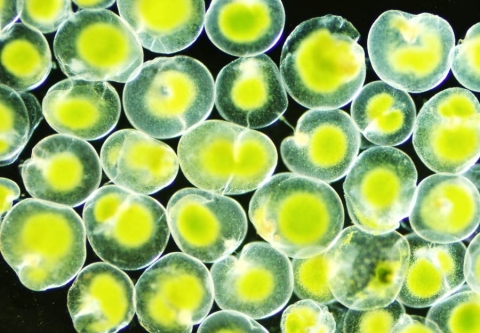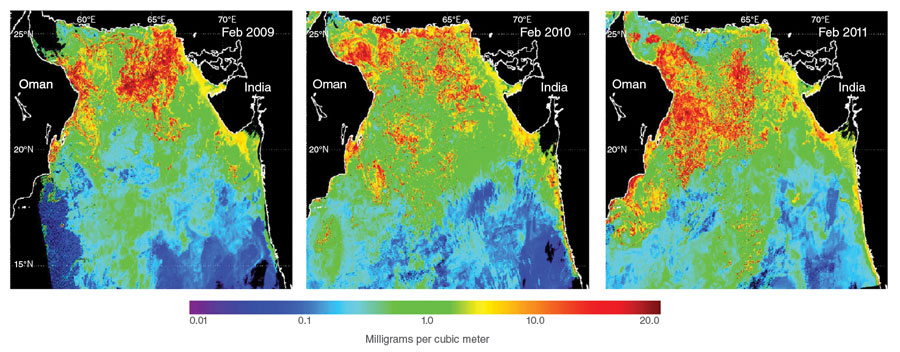Two strange things unfolded in the Arabian Sea in the winter of 2003. Joaquim Goes, an oceanographer and remote sensing expert, studied satellite images of summer algal blooms when he thought to check winter blooms. The amount of algae astounded him. Then, Goes’ colleagues found themselves sailing their research vessel through slushy, green waters. They took samples and sent word to Goes. “It was an organism called Noctiluca scintillans,” Goes said. “It’s never been seen in the Arabian Sea.”
Noctiluca is a kind of microalgae, or tiny plant-like organism. Sailors call them sea sparkles because they glimmer at night. From space, they appear like most algae—emerald green swirls in cobalt blue seas. Under the microscope, they look like transparent, quivering balloons with whip-like tails. The green blooms could have been Noctiluca or other species of algae like diatoms, cyanobacteria, or coccolithophores. Whatever it was, Goes was intrigued. “Why was this organism appearing in such large quantities?” he said. “And why was it happening in the Arabian Sea?”
Much ado about algae
Algae range from minute organisms to billowy, underwater forests of kelp. But in the algal pecking order, size is not king. One-celled algae, known as phytoplankton, form the base of the ocean’s food chain. Minute cyanobacteria and coccolithophores drift on the ocean’s sunlit surface, converting carbon dioxide (CO2) and water into high-energy compounds through photosynthesis. Larger phytoplankton like diatoms and dinoflagellates photosynthesize too and feed on nutrients floating nearby. These phytoplankton are gobbled up by small sea animals, or zooplankton, which are in turn eaten by larger fish and sea creatures.
In a bigger role, phytoplankton produce half of Earth’s oxygen. They also suck CO2 from the atmosphere and sequester it into the ocean depths when they die and sink. Annually, phytoplankton absorb 20 percent more carbon than the world’s forests. A small change in phytoplankton growth can affect the global carbon cycle.
Scientists are particularly interested in phytoplankton blooms that grow out of control. Harmful blooms produce toxins that can kill marine animals and poison humans. Goes and biological oceanographer Helga do Rosario Gomes have been studying blooms in the Arabian Sea, a pirate-infested stretch of water northwest of the Indian Ocean bound by the Horn of Africa on the west, Pakistan in the north, and India in the east. They monitor these using data from NASA"s Moderate Resolution Imaging Spectroradiometer (MODIS), a satellite sensor that detects changes in the green pigment chlorophyll, present in all plants and essential in photosynthesis.
In the summer of 2003, satellites detected that the sea was crazy with photosynthetic action. “The Arabian Sea’s productivity was rapidly increasing,” Goes said. The researchers found that intense southwest monsoon winds caused the summer uptick in phytoplankton.
Shrinking snowcaps in the Himalaya caused the Indian subcontinent to become warmer than usual in the summer. This formed an intense low-pressure area over the subcontinent, which sucked in a stronger southwest wind from the Arabian Sea. These winds then generated strong upwelling near the coasts of Yemen and Oman, drawing colder, nutrient-rich water from the depths to the surface. The influx of nutrients overfed phytoplankton, causing populations to explode.
Winter was another story. “The Himalayan snowcap was shrinking and winter winds were also warmer and more humid,” Gomes said. “We thought winter convective mixing should have been decreasing along with phytoplankton populations.” But satellite data showed these conditions had the opposite effect on phytoplankton. Something else was causing the burgeoning winter blooms.
An ominous switch
Beginning in 2009, Goes and Gomes spent three winters on the research vessel Sagar Sampada, sailing off the coast of Goa transecting through blooms in the northern Arabian Sea. The satellites were indeed seeing Noctiluca, the green kind that lives in tropical waters. Red Noctiluca lives in temperate waters. The researchers monitored satellite data, collected bloom samples, and performed shipboard experiments, which led to more questions than answers.
Goes and Gomes collaborated with NASA oceanographer Jeremy Werdell on an algorithm to detect green Noctiluca blooms in MODIS data. “Since they were first detected in the early 2000s, blooms of the green Noctiluca now occur every year with predictable regularity from January to March,” Gomes said. According to historical records and other research missions, diatoms dominated the Arabian Sea before 2000. Khalid Al-Hashmi, a researcher at Oman’s Sultan Qaboos University, said there were sporadic Noctiluca sightings in the 1950s and 1980s, but only along India’s western coast. Goes said, “Within a decade, Noctiluca had totally replaced diatoms at the base of the Arabian Sea’s food chain.”
This does not bode well for the region’s fishermen. Zooplankton have no trouble eating diatoms but cannot eat Noctiluca because they are too big. If zooplankton starve and die, larger creatures up the food chain are compromised. Shipboard experiments confirmed that Noctiluca were indeed outcompeting the diatoms. “They were short-circuiting the food chain,” Goes said. Only jellyfish, sea salps, and turtles can feed on Noctiluca, so this trend could upend the Arabian Sea’s fishing industries.
The researchers also noticed that blooms coincided with hypoxic seawater, or water low in oxygen. “Big cities in India and the Middle East release lots of sewage water into the Arabian Sea. Nitrogen and phosphorus from agricultural runoff contribute to a decrease in seawater oxygen concentration, causing the spread of hypoxia,” Goes said. The researchers checked historical archives again to see past levels. “We saw a trend of rapid decreases in oxygen concentration in the last seven years,” Goes said. The trend roughly coincided with the switch from diatoms to Noctiluca, so they suspected the two were connected. But how?
In the dead zone
In hypoxic waters, slow-moving creatures like crabs and lobsters do not stand a chance. Fish fall unconscious and suffocate. These biological dead zones form when phytoplankton feast on a flush of nutrients and reproduce dramatically. Huge populations of bacteria need oxygen to metabolize the waste as well as the dead phytoplankton sinking from the sea surface. “In the process, they strip the water of oxygen,” Goes said. Water circulation is sluggish in the Arabian Sea, so oxygen-starved water does not get replaced as fast as it does in the Pacific or Atlantic Oceans.
But the connection between hypoxia and the phytoplankton switch did not make sense. Diatoms need CO2, not oxygen, for photosynthesis. Noctiluca eat smaller phytoplankton which also only require CO2. So the researchers took a closer look at how the two organisms behave in hypoxic conditions.
In the ship lab, the researchers transferred Noctiluca and its diatom competitors into airtight bottles of oxygen-starved seawater. They looked at how well the organisms converted CO2 to energy—a way to measure productivity. Noctiluca’s rate rose by 300 percent, while the rate of the diatoms’ fell by nearly as much. “Noctiluca just did better,” Gomes said. “It started growing faster.” They also found that Noctiluca grew faster in light than in the dark, thanks to millions of sun-loving endosymbionts living within its cell walls.
The endosymbionts seem key to Noctiluca’s advantage. These are smaller phytoplankton that convert CO2 to energy by photosynthesis and pass the energy on to Noctiluca like rent. It is additional food for Noctiluca, which are not capable of photosynthesis and usually feed on other phytoplankton, zooplankton eggs, and decaying organic particles in seawater.
“This endosymbiont evolved 1. 2 billion years ago in an atmosphere that was rich in CO2 and low in oxygen,” Goes said. “We think that it conserved this gene for photosynthesizing in a low-oxygen environment and now that hypoxic waters are coming to the surface, these genes are overexpressing themselves and allowing the Rubisco enzyme to function better.”
The chief architect
Rubisco is an ancient enzyme present in all plants and responsible for the conversion of CO2 into organic compounds. Old sedimentary rocks in Zimbabwe and Canada place its appearance 2.9 billion years ago when Earth was a much different place. Continents were still forming and stabilizing, and air was mostly CO2. There were no plants or animals, just bacteria-like life and multicellular organisms. Somehow, Rubisco enabled Precambrian phytoplankton to capture CO2 from the atmosphere and produce oxygen. The change was radical. Scientists have called Rubisco “the chief architect of the atmosphere.”
Goes and Gomes have a hunch that the Arabian Sea’s low-oxygen waters are somehow causing the Rubisco within the endosymbiont to perform better, resulting in more energy for the Noctiluca.
James V. Moroney, a molecular biologist at Louisiana State University (LSU), thinks it’s possible. “Oxygen competes with CO2 in Rubisco. If you lower oxygen, that could enhance carbon fixation in the endosymbiont,” he said. Diatoms, on the other hand, have the ability to concentrate CO2 around Rubisco to make it perform better. “Dropping the oxygen a bit shouldn’t make much difference to the diatoms,” he said.
Moroney does caution that not enough is known about Noctiluca nor its endosymbiont to draw any conclusions. Senjie Lin, an expert in phytoplankton genomics at the University of Connecticut, agrees. “Rubisco may very likely play a role here,” Lin said. “But the situation may be more complex than we understand right now.” Lin is analyzing the endosymbiont’s RNA to see whether a gene that codes for the Rubisco enzyme is indeed responding to hypoxic conditions in the Arabian Sea.
Though the Rubisco hypothesis is fascinating, Goes and Gomes are also checking other leads. Noctiluca could be responding to nutrients brought by dust plumes. And because hypoxic waters tend to be acidic, the researchers are looking at the sea’s pH levels, wondering whether acidification is also promoting the growth of Noctiluca.
Goes, Gomes, and their colleagues continue to chase more questions. Meanwhile, cities and populations around the Arabian Sea expand. What will the rise of Noctiluca bring? Will it leave a sparkling dead sea, or will it shift the food web, restructuring the ecological design of these waters?
References
Al-Hashmi K., C. L. Smith, M. Claereboudt, S. A. Piontkovski, and A. R. Al-Azri. 2015. Dynamics of potentially harmful phytoplankton in a semi-enclosed bay in the Sea of Oman. Bulletin of Marine Science 91, doi:10.5343/bms.2014.1041.
Goes, J. I., P. G. Thoppil, H. d. R. Gomes, and J. T. Fasullo. 2005. Warming of the Eurasian landmass is making the Arabian Sea more productive. Science 308: 545–547.
Gomes, H. d. R., J. Goes, S. G. P. Matondkar, E. J. Buskey, S. Basu, S. Parab, and P. Thoppil. 2014. Massive outbreaks of Noctiluca scintillans blooms in the Arabian Sea due to spread of hypoxia. Nature Communications 5: 4862, doi:10.1038/ncomms5862.
Lin, X., H. Zhang, Y. Cui, and S. Lin. 2012. High sequence variability, diverse subcellular localizations, and ecological implications of alkaline phosphatase in dinoflagellates and other eukaryotic phytoplankton. Frontiers in Microbiology, doi:10.3389/fmicb.2012.00235.
Moroney, J. V., and R. A. Ynalvez. 2009. Algal Photosynthesis. In: Encylopedia of Life Sciences. John Wiley & Sons, Ltd: Chichester, doi:10.1002/9780470015902.a0000322.pub2.
NASA Ocean Biology DAAC (OB.DAAC). Level 2 Ocean Color Web. Greenbelt, MD, USA. http://oceancolor.gsfc.nasa.gov/cms.
NASA Socioeconomic Data and Applications Center (SEDAC). Gridded Population of the World (GPW), v3. Palisades, NY, USA. http://sedac.ciesin.columbia.edu/data/collection/gpw-v3.
Werdell, J., C. S. Roesler, and J. I. Goes. 2014. Discrimination of phytoplankton functional groups using an ocean reflectance inversion model. Applied Optics 53: 4,833–4,843, doi:10.1364/AO.53.004833.
For more information
NASA Ocean Biology Distributed Active Archive Center (OB.DAAC)
NASA Socioeconomic Data and Applications Center (SEDAC)
NASA Moderate Resolution Imaging Spectroradiometer (MODIS)
Goes-Gomes Lab at Columbia University’s Lamont Doherty Earth Observatory
| About the data | ||||
| Satellite | Aqua | |||
| Sensor | Moderate Resolution Imaging Spectroradiometer (MODIS) | |||
| Data sets | Level 2 Ocean Color Web | Gridded Population of the World | ||
| Resolution | 2 kilometers | 2.5 arc-minute 1/4 degree, 1/2 degree, 1 degree | ||
| Parameters | Chlorophyll a concentration | Population density | ||
| DAACs | NASA Ocean Biology Distributed Active Archive Center (OB.DAAC) | NASA Socioeconomic Data and Applications Center (SEDAC) | ||






